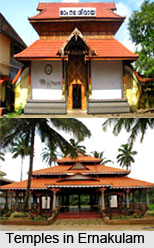 Ernakulam is the downtown area or the western part of the mainland of Kochi city in Kerala, India. Ernakulam is located at an average elevation of 4 m. The city is the most urban part of Kochi and has lent its name to the Ernakulam district. Ernakulam is called the commercial capital of the state of Kerala. The Kerala High Court, the Office of the Corporation of Cochin and the Cochin Stock Exchange are situated here. The city has served as an incubator for many Malayali entrepreneurs and is a major financial and commercial hub of Kerala.
Ernakulam is the downtown area or the western part of the mainland of Kochi city in Kerala, India. Ernakulam is located at an average elevation of 4 m. The city is the most urban part of Kochi and has lent its name to the Ernakulam district. Ernakulam is called the commercial capital of the state of Kerala. The Kerala High Court, the Office of the Corporation of Cochin and the Cochin Stock Exchange are situated here. The city has served as an incubator for many Malayali entrepreneurs and is a major financial and commercial hub of Kerala.
History of Ernakulam
Starting from the Stone Age, Ernakulam has been the site of human settlement. Monolithic monuments like Dolmens and rock-cut caves can be seen in many parts of Ernakulam.
Etymology
Ernakulam was also known as "Rishinagakulam" in ancient days. The word `Ernakulam` has been derived from the name of a very famous temple of Lord Shiva called the Ernakulathappan Temple. It is also said that the word Ernakulam has been taken from Malayalam words `Ere naal Kulam`, that means `Pond for a long time`.
Climate in Ernakulam
Since the region lies in the south western coastal state of Kerala, the climate is tropical, with only minor differences in temperatures between day and night, as well as over the year. Summer lasts from March to May, and is followed by the South-west monsoon from June to September. October and November form the post monsoon or retreating monsoon season. Winter from December through February is slightly cooler and windy, due to winds from the Western Ghats. The city is drained in the monsoon season by heavy showers.
Demographics of Ernakulam
According to the 2011 census Ernakulam district has a population of 3,282,388. Ernakulam has a sex ratio of 1028 females for every 1000 males, and a literacy rate of 95.68%. This district is listed as the "most advanced" district in Kerala.
 Economy of Ernakulam
Economy of Ernakulam
Ernakulam is regarded as the centre of business in Kerala. Ernakulam is a major financial and commercial hub of Kerala. The Cochin Port, Cochin Shipyard has resulted in the faster growth of the city. Tourism has also contributed heavily to the economy of Ernakulam.
Temples in Ernakulam
The city with its temples, old churches and its culture is ranked first in the number of domestic tourists visiting Kerala. There are many holy places like temples to visit in Ernakulam. The temples that are located here are Ernakulathapan temple dedicated to Lord Shiva, Hanuman Temple, Muruga Temple, Valanjambalam Devi Temple, Ravipuram Srikrishna Swamy Temple.
Places of Interest
•Marine Drive, Kochi: Enjoy a scenic view of the sea and the Cochin Port. Two spectacular bridges have also been built along the shore. Boat rides are available.
•Chinese Fishing Nets can be seen at Fort Cochin.
Hill Palace Museum is at Tripunithura. Paintings, epigraphy and furniture of the royal family are displayed.
•Bolgatty Island has a palace built by the Dutch in 1744 and a golf course.
•Willington Island: Formed from the sand deposited when Cochin Port was deepened.
•Kodanad: Elephant training centre is located here.
•Parikshith Museum, a museum with memories of 19th century.
•Dutch Palace: Made in 1568 by the Portuguese. Later re-structured by the Dutch.
•Kerala Historical Museum is located at Edappally, on the Aluva-Ernakulam road.
•Chendamangalam, a village that is the location of the Paliam palace, Vypeenakotta Seminary, and is also remarkable for having a Hindu Temple, Synagogue, Church, and Mosque, all within 1km of each other.
•Bhoothathankettu, a scenic dam site with boating facilities is situated in a vast virgin forest.
•St. Thomas Syro-Malabar Catholic Church, Malayattoor is the only international shrine in Asia.
•Wonder La, Kakkanad is one of the most important amusement parks in the south India. It is locate at Pallikkara near to Kakkanad.
Transport
There are two railway stations in Ernakulam City; Ernakulam Town railway station and Ernakulam Junction Railway Station. Ernakulam city is served by Cochin International Airport, which is about 27 kilometers away.



















